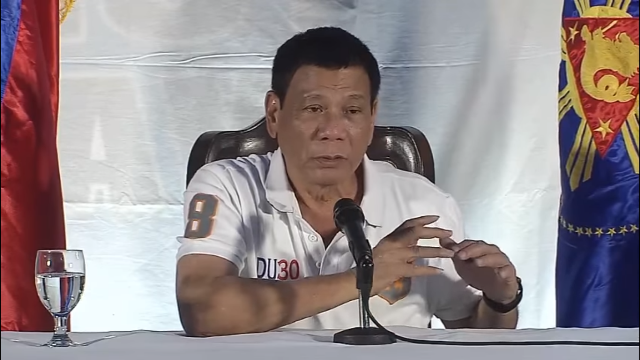Duterte’s Purge: Media Contribute to Confusion

Screengrab from the RTVMalacanang Youtube account.
EXPRESSING HIS “disappointment” over reports of persistent corruption in the government particularly in regional offices, President Rodrigo Duterte announced in one of his weekend press conferences that all government officials appointed by the president should consider their positions vacant. Speaking to media in the Department of Public Works and Highways (DPWH) Panacan Depot in Davao City last August 21, Duterte said:
“I would like to issue a warning that on Monday (August 22) I would declare all positions in the government that are presidential appointments… if you are there because of presidential appointments I will declare all your positions all throughout the country vacant. You know why? Until now in my provincial visits I still hear corruption being committed by people especially in the regulatory agencies. I would like to point out one. The LFTRB… LTFRB, the regulation board. I forgot his name, but come to me and see me in Malacanang. The LTO and those who are appointed to the positions of LTO except the career, consider your positions vacant as of this hour. All of them, lahat. It will number in thousands. Consider yourself in the crucible of the truth about corruption in this country.”
Print and broadcast media quickly picked up on this statement. TV reports were able to report that current cabinet officials are exempted from Duterte’s announcement—this was stated by Duterte himself in response to a follow-up question raised during the press conference. However, presidential legal counsel Salvador Panelo said that the list of those who should resign still needs to be clarified.
But print media seemed to be even more confused, reporting that the order affects “all” presidential appointees.
It was only a day later that official clarification was issued by the president’s communications staff, who also seemed confused about who were included in Duterte’s announcement. Presidential spokesperson Ernesto Abella said in a morning press briefing in Malacanang last August 22 that the order only referred to the appointees of former President Benigno Aquino III, and to Duterte appointees Edgar Galvante and Martin Delgra, the heads of LTO and LTFRB, respectively.
However, the memorandum circular on courtesy resignations released in the evening of August 22 and signed for the president by Executive Secretary Salvador Medialdea showed that Galvante and Delgra were actually not compelled to submit their resignations, since they had been included in the list of exempted appointees. Reports from Rappler and GMA News Online pointed out that Galvante and Delgra both had the rank of assistant secretary– a rank which is not covered by the memorandum circular. The Philippine Star also reported that Duterte, in another Malacanang press conference held last August 25, said that “some people continue their corrupt practices despite his warnings, but he is convinced that LTO chief Edgar Galvante and LTFRB chairman Martin Delgra III have nothing to do with corruption.”
The written directive said, “Until any action on their courtesy resignations is taken by the President, appointive officials shall continue to report for work and perform their normal duties and responsibilities.” The media did not ask whether the Aquino appointees that President Duterte was referring to have previously tendered their resignations and are in fact functioning on holdover capacity, or whether they re-filed their resignations upon the release of the circular.
By merely relying on the president’s words and using these as basis for their news reports, the media inadvertently contributed to the confusion. The media also contributed to the idea that the Aquino appointees Duterte had wanted to resign are holding on to their posts to continue with corrupt practices – a general accusation so patently unfair in this situation. Media should actually learn more about the terms of political appointment – which through the many transitions in the past had never quite created this kind of a problem.
If media were better informed, they could have challenged the veracity and logic of the statements of top government officials, including those of the president.
Or have the media become afraid?
Leave a Reply